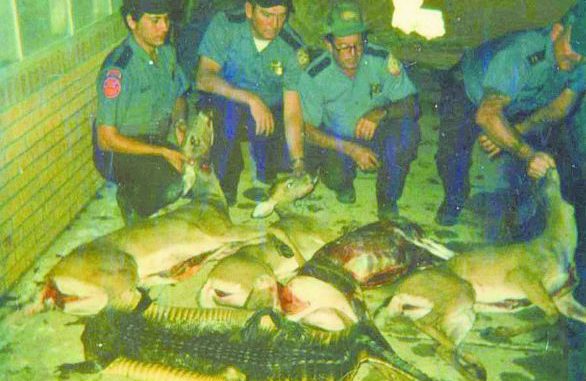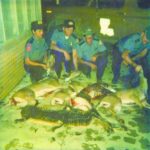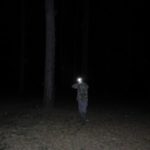
Poachers feel safe stalking prey in the dark
One dark Friday night in early November 1977, under the direction of an older, more-experienced wildlife enforcement officer, I parked the Bronco overlooking a large area of recently harvested soybean fields.
Using the roof of the cab as an observation deck, we could see for miles around. What we saw was not much of a surprise to him, but it was pretty overwhelming to me.
In every direction of this roadless area we could see the lights of moving vehicles. From most of the nine vehicles we counted, spotlights were diligently sweeping the ground. Others simply prowled slowly along apparently hoping to see something interesting in the headlights.
Some of the vehicles were trucks and others were three-wheelers, but they were all engaged in the same illegal activity.
They were night hunting.
It is sad to say, but this was a typical Friday or Saturday night scenario at that time and place.
Hunting seasons were open, and the area held numerous hunting camps filled with weekend hunters. Going out to poach a deer for a little “camp meat” on the first night in camp was a standard, widespread and socially acceptable practice.
The fact that it was an acceptable practice among the locals was the most-significant problem we as wildlife agents faced in combating the problem.
But it was, by far, not our only challenge.
This was low swamp and river bottom country. It got muddy and wet with the first rains of November and stayed that way until late spring or early summer, depending on rainfall amounts and backwater flooding.
Getting around required four-wheel drive trucks well equipped with mud grips and winches. The 1973 model Ford Bronco assigned to me was the only Department of Wildlife and Fisheries 4X4 in the parish.
The remaining vehicles were two-wheel drive pickups, and they were lucky to make it down an unpaved secondary roads after a rain. Pursuing a night hunter on the turn rows of a wet, stiff-land-clay bean field or a deeply rutted woods road was out of the question.
Even the Bronco was outclassed in many cases by 4X4s with raised suspensions, better tires and winches.
Manpower-wise we were spread pretty thin, as well. Our patrol area included vast areas of Red and Atchafalaya river bottomland, and the four or five agents working on any given night could only patrol a few locations.
Coverage was further reduced by the need to pair up or work in close proximity to each other for officer safety and multiple-suspect situations. Rarely did we find vehicle night hunters working alone, and many times two or more violators would be in the truck with Jim Beam or Jack Daniels riding along, as well.
Making matters worse was the fact that a lot also went on during the day.
Deer and waterfowl seasons were open, and illegal deer and over-limit violations begged attention. We could not and did not ignore daytime violations, and simply ended up donating a lot of work hours in excess of the 40 per week for which we were paid.
So we ended up with long hours and low pay, but it was anything but boring. Fuel up the truck, fill the coffee thermos and go set up for surveillance where the most-recent and reliable reports of night hunting took us.
If conditions were right, it wouldn’t be long before a shot was heard or a light was seen, and the game began.
A good wildlife agent learns from his experiences and from the more-senior agents around him. I learned a lot from both.
It did not take long to realize it was a waste of time to work where access was impossible. Nothing was gained but frustration by watching a spotlight and listening to shots coming from inaccessible places.
So I focused on areas where the odds favored being able to contact and stop a suspect vehicle. I particularly enjoyed going after night poachers who hunted on foot for deer or rabbits. With both of us on foot, odds were even, and those guys usually worked alone, off the beaten path — and most thought they were completely safe from apprehension.
A couple of the older agents taught me a lot about separating the wheat from the chaff of violation complaints. One old veteran advised me to dismiss any complaint claiming someone night hunting the same location every night.
“Nobody hunts every night,” he said. “And nobody is going to hunt the same place every night. After one or two hunts the game has been killed, and the outlaw is going somewhere else. But if they tell you there’s a good bit of game around and someone drives through shining now and then or shots are heard from time to time, that’s more likely true and worth looking into. But every night — that’s bull.”
A similar situation involved one man in a community who was being accused of hunting every night and killing everything that moved in the entire country. The man did hunt raccoons at night legally, and I suspect he might have killed a deer from time to time.
But he could not be in more than one place at a time, and we were getting reports putting him in three or four locations on the same night.
He was a good coon hunter, and hide prices were great in those days. Jealousy was probably a factor in the reporting.
It got so bad, the agent getting all the calls came up with an ingenious plan to deal with it.
He called me and said he needed me to work with him that night, but did not say why. I met him a little before dark. We got in his truck and drove to the accused coon hunter’s home.
The coon hunter answered the door, looking very surprised.
I did not know why we were there, either, but the agent told the hunter to get his coat and come with us. The man complied, and we put him in the truck between us and drove away.
The rest of the night we patrolled as normal and kept him with us all night.
At break of day the next morning, we dropped him off at home. Later that day, as usual, the agent received multiple calls accusing our hunter of poaching in three of four areas just last night.
The agent let the callers know where the suspect had been the night before —in our company — and filing false reports was illegal.
Things quieted down after that.
I also learned to beware of people who frequently reported violations that never amounted to anything or those who were very curious about when and where I would be working.
“Keep your schedule and your whereabouts to yourself,” the older guys advised. “Some people just want to know where you are and when you’ll be there so they can safely poach somewhere else.”
As mentioned earlier, social acceptance of poaching was the most-difficult thing to overcome. Many people felt poaching to put meat on the table was acceptable.
And if I had a dollar for every time I heard “It’s OK if they eat it, but wrong if they sell it,” I could buy that land in Wyoming.
How we were supposed to tell the difference I don’t know, and the wildlife was just as dead and stolen from honest sportsmen either way.
Over time compliance has gotten better. For many reasons, illegal night hunting, as well as other types of poaching, are not as common any more.
Better education, less tolerance for poaching and more awareness of the need for wildlife conservation are just a few reasons for the change.
Another big reason (I believe) is the protection provided by dedicated, well-trained and well-equipped wildlife enforcement agents. But we are only as good as the laws and regulations we enforce.
Just prior to writing this column, I stopped in at the office to visit with some of my wildlife enforcement agent buddies still on the job. During our conversation they mentioned an increase in reports of illegal night hunting locally. We discussed the locations and a couple of possible suspects.
Later in the day, my thoughts turned to some of the more-liberal regulations we now have allowing the killing of coyotes, armadillos, feral hogs, nutria and beaver on private land.
From the last day of February to the last day of August they may be shot at night. Lights, infrared or laser sights, night vision gear and firearm sound suppressors are all OK.
We all understand why these measures are necessary, but we also understand that encouraging night-shooting and the vigorous marketing of equipment for better, more-efficient night shooting might direct less-than-desirable attention in directions we might well wish it had never gone.
Report violations to your nearest wildlife enforcement agent or use the 24-hour toll free Operation Game Thief Hotline 1-800-442 2511.




